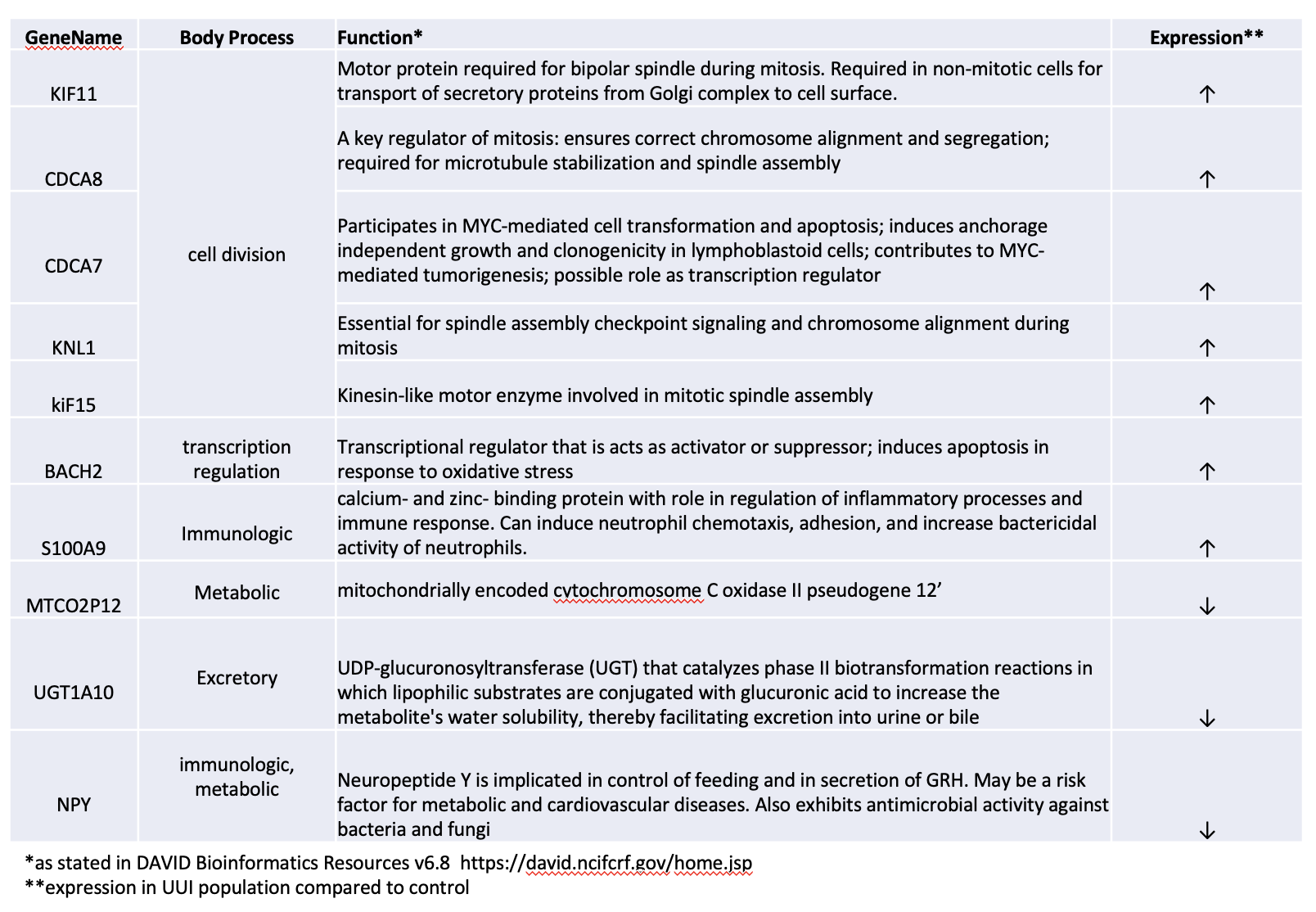Back
Poster, Podium & Video Sessions
Moderated Poster
MP49: Urodynamics/Lower Urinary Tract Dysfunction/Female Pelvic Medicine: Basic Research & Pathophysiology
MP49-06: Significant Differences in Urothelial Gene Expression Among Women with UUI
Sunday, May 15, 2022
4:30 PM – 5:45 PM
Location: Room 228
Gabrielle McNary*, Joseph Prinz, Carole Grenier, Cindy Amundsen, Susan Murphy, Nazema Siddiqui, Durham, NC
- GM
Gabrielle Mcnary, MD
Resident
Duke University Medical Center
Poster Presenter(s)
Introduction: Urgency urinary incontinence (UUI) is a common complaint with increasing prevalence in the aging population. UUI refers to loss of bladder control occurs following a strong, sudden need to urinate. In idiopathic UUI, the pathophysiologic mechanisms underlying bladder dysfunction are not clear. We hypothesized that women with idiopathic UUI have differential expression of urothelial regulatory genes involved in sensory neural signaling. As such, our main objective was to compare urothelial gene expression between women with idiopathic UUI and matched controls. A secondary objective was to perform pathway analyses to understand if specific regulatory or signaling pathways are implicated in idiopathic UUI.
Methods: Women with idiopathic UUI (defined as >3 UUI episodes per week, confirmed with validated questionnaires), and matched controls were recruited for this study. Participants underwent office cystoscopic biopsies which were placed in RNAlater, transferred to the research laboratory on dry ice, and frozen at -80C. RNA was extracted using the Qiagen All Prep DNA/RNA mini kit followed by quantification and calculation of RNA Integrity Number (RIN). Samples with >400ng RNA with RIN>7 underwent expression profiling with RNA-sequencing. Expression profiles were compared between groups using a linear model that also adjusted for age, race, BMI, hypertension, and RIN. False discovery rate adjustments were calculated to control for multiple testing with Padj <0.05 considered significant. Genes with the largest margins of difference (e.g., fold change) were assessed for biological significance.
Results: A total of 45 women (30 UUI, 15 control) were included. Baseline characteristics were not statistically different between groups. 668 genes were differentially expressed (Padj <0.05). Of those with the highest significance threshold (Padj <0.01), 10 genes were found to be differentially expressed at a fourfold magnitude difference (Table 1).
Conclusions: Several genes were found to be differentially expressed in women with idiopathic UUI compared to matched controls. Specifically, genes involved in cell division and the immunologic response were significantly differentially expressed to a large degree. Additional study of these genes and their pathways may lead to new discoveries and therapies related to UUI treatment.
Source of Funding: Research reported was supported by a grant from the National Institutes of Health.

Methods: Women with idiopathic UUI (defined as >3 UUI episodes per week, confirmed with validated questionnaires), and matched controls were recruited for this study. Participants underwent office cystoscopic biopsies which were placed in RNAlater, transferred to the research laboratory on dry ice, and frozen at -80C. RNA was extracted using the Qiagen All Prep DNA/RNA mini kit followed by quantification and calculation of RNA Integrity Number (RIN). Samples with >400ng RNA with RIN>7 underwent expression profiling with RNA-sequencing. Expression profiles were compared between groups using a linear model that also adjusted for age, race, BMI, hypertension, and RIN. False discovery rate adjustments were calculated to control for multiple testing with Padj <0.05 considered significant. Genes with the largest margins of difference (e.g., fold change) were assessed for biological significance.
Results: A total of 45 women (30 UUI, 15 control) were included. Baseline characteristics were not statistically different between groups. 668 genes were differentially expressed (Padj <0.05). Of those with the highest significance threshold (Padj <0.01), 10 genes were found to be differentially expressed at a fourfold magnitude difference (Table 1).
Conclusions: Several genes were found to be differentially expressed in women with idiopathic UUI compared to matched controls. Specifically, genes involved in cell division and the immunologic response were significantly differentially expressed to a large degree. Additional study of these genes and their pathways may lead to new discoveries and therapies related to UUI treatment.
Source of Funding: Research reported was supported by a grant from the National Institutes of Health.


.jpg)
.jpg)